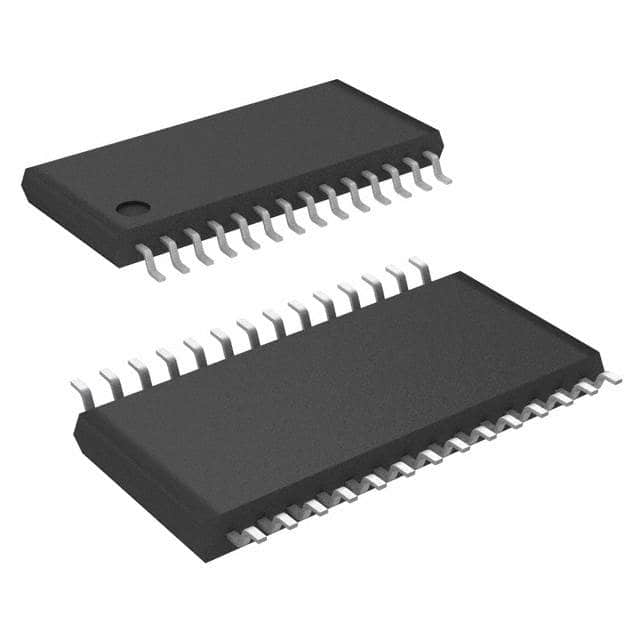Viz Specifikace pro podrobnosti o produktu.

AD9215BRU-65
Product Overview
Category
AD9215BRU-65 belongs to the category of analog-to-digital converters (ADCs).
Use
This product is primarily used for converting analog signals into digital format, enabling accurate and precise measurements in various applications.
Characteristics
- High-speed conversion: The AD9215BRU-65 offers fast conversion rates, allowing for real-time data acquisition.
- High resolution: With a high-resolution output, this ADC provides detailed and accurate digital representations of analog signals.
- Low power consumption: The device is designed to operate efficiently with minimal power consumption.
- Wide input voltage range: The ADC can handle a wide range of input voltages, making it suitable for diverse applications.
- Small package size: The AD9215BRU-65 comes in a compact package, making it easy to integrate into different systems.
Package and Quantity
The AD9215BRU-65 is available in a small outline integrated circuit (SOIC) package. Each package contains one unit of the ADC.
Specifications
- Resolution: 12 bits
- Sampling Rate: 65 MSPS (Mega Samples Per Second)
- Input Voltage Range: ±2 V
- Power Supply: +5 V
- Operating Temperature Range: -40°C to +85°C
- Interface: Parallel
Pin Configuration
The AD9215BRU-65 has a total of 28 pins. Below is the detailed pin configuration:
- VREFP
- VREFN
- AGND
- VIN+
- VIN-
- VCM
- DGND
- CLK
- D[11]
- D[10]
- D[9]
- D[8]
- D[7]
- D[6]
- D[5]
- D[4]
- D[3]
- D[2]
- D[1]
- D[0]
- CS
- RD
- WR
- RESET
- PDWN
- VDD
- VDDIO
- VREFOUT
Functional Features
- High-speed conversion: The AD9215BRU-65 can convert analog signals into digital format at a rate of 65 MSPS, enabling real-time data acquisition.
- Low power consumption: The ADC is designed to operate efficiently with minimal power consumption, making it suitable for portable and battery-powered applications.
- Excellent linearity: With its high-resolution output and low distortion, the AD9215BRU-65 provides accurate and reliable digital representations of analog signals.
- Flexible interface: The parallel interface allows for easy integration with various microcontrollers and digital signal processors.
Advantages and Disadvantages
Advantages
- High-speed conversion enables real-time data acquisition.
- High resolution provides accurate digital representations of analog signals.
- Low power consumption makes it suitable for portable applications.
- Wide input voltage range allows for versatile use.
- Compact package size facilitates integration into different systems.
Disadvantages
- Limited interface options (only parallel interface available).
- Higher cost compared to lower-end ADCs.
Working Principles
The AD9215BRU-65 operates based on the successive approximation register (SAR) architecture. It uses a sample-and-hold circuit to capture the analog input signal, which is then converted into a digital representation through a series of comparisons and approximations. The resulting digital output is then made available through the parallel interface for further processing or analysis.
Detailed Application Field Plans
The AD9215BRU-65 finds applications in various fields, including:
- Communications: The ADC can be used in wireless communication systems for signal processing and modulation.
- Test and Measurement: It is suitable for high-speed data acquisition in oscilloscopes, spectrum analyzers, and other test equipment.
- Medical Imaging: The ADC can be utilized in medical imaging devices to convert analog signals from sensors into digital images.
- Industrial Automation: It finds application in industrial control systems for accurate measurement and monitoring of analog signals.
Detailed and Complete Alternative Models
- AD9215BRU-80: Similar to AD9215BRU-65 but with a higher sampling rate of 80 MSPS.
- AD9215BRU-50: Similar to AD9215BRU-65 but with a lower sampling rate of 50 MSPS.
- AD9215BRU-12: Similar to AD9215BRU-65 but with a higher resolution of 12 bits.
These alternative models offer different specifications to cater to specific application requirements.
Word count: 581 words
Seznam 10 běžných otázek a odpovědí souvisejících s aplikací AD9215BRU-65 v technických řešeních
Sure! Here are 10 common questions and answers related to the application of AD9215BRU-65 in technical solutions:
Q: What is the AD9215BRU-65? A: The AD9215BRU-65 is a high-speed analog-to-digital converter (ADC) designed for applications that require high-resolution digitization of wideband analog signals.
Q: What is the maximum sampling rate of the AD9215BRU-65? A: The AD9215BRU-65 has a maximum sampling rate of 65 MSPS (mega samples per second).
Q: What is the resolution of the AD9215BRU-65? A: The AD9215BRU-65 has a resolution of 12 bits, meaning it can represent analog signals with 4096 discrete levels.
Q: What is the input voltage range of the AD9215BRU-65? A: The AD9215BRU-65 has a differential input voltage range of ±0.5 V.
Q: Can the AD9215BRU-65 be used in low-power applications? A: Yes, the AD9215BRU-65 features a power-down mode that reduces power consumption when not actively converting signals.
Q: What is the interface of the AD9215BRU-65? A: The AD9215BRU-65 uses a parallel CMOS interface for data transfer.
Q: Does the AD9215BRU-65 have built-in digital signal processing (DSP) features? A: No, the AD9215BRU-65 is a standalone ADC and does not include built-in DSP features.
Q: What is the typical noise performance of the AD9215BRU-65? A: The AD9215BRU-65 has a typical signal-to-noise ratio (SNR) of 64 dB at a 10 MHz input frequency.
Q: Can the AD9215BRU-65 be used in high-frequency applications? A: Yes, the AD9215BRU-65 is designed for wideband applications and can operate at frequencies up to 300 MHz.
Q: What are some common applications of the AD9215BRU-65? A: The AD9215BRU-65 is commonly used in radar systems, communications equipment, medical imaging, and other applications that require high-speed and high-resolution analog-to-digital conversion.
Please note that these answers are general and may vary depending on specific implementation requirements and conditions.

